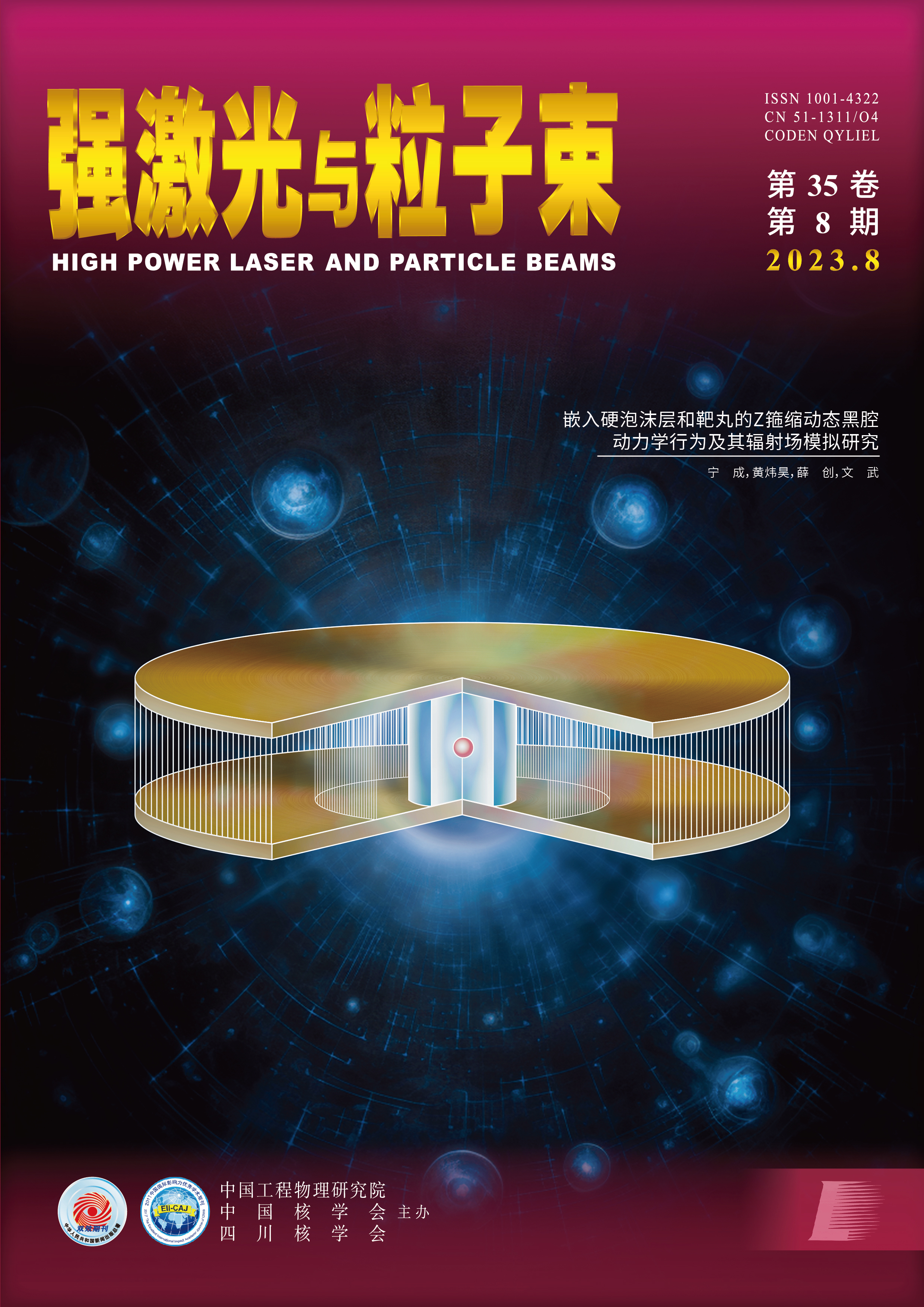2023 Vol. 35, No. 8
- Cover and Contents
- Laser Damage of Optical Elements
- High Power Laser Physics and Technology
- Operation and Maintenance of Large Scale Scientific Facility
- Inertial Confinement Fusion Physics and Technology
- High Power Microwave Technology
- Particle Beams and Accelerator Technology
- Pulsed Power Technology
- Nuclear Science and Engineering
- Advanced Interdisciplinary Science
- Research News
Defects and impurities in optical components can lead to significant reduction in the laser damage threshold, which has become a “bottleneck” in the development of high-power and high-energy laser devices and needs to be solved urgently. In the study...
Laser driven inertial confinement fusion (ICF) has attracted much attention for its potential to solve the global energy crisis. As fused silica is an important functional ultraviolet (UV) element in the final optics assembly of ICF device, its laser...
The bidirectional output fiber laser can achieve two laser outputs through a resonant cavity structure, which can reduce the volume and cost of high-power fiber laser systems and has good application prospects in the industrial field. Based on the os...
Time-resolved X-ray absorption fine structure spectrum technology needs to produce X-ray source with high brightness, uniform and wide spectrum. The M-band radiation source generated by an elementary target has high brightness, but poor uniformity. T...
Combined with the heat transfer mechanism of honeycomb structure and the ablation mechanism of composites, the thermal response of honeycomb sandwich composite structure under laser irradiation was studied. For typical honeycomb cells, a theoretical ...
For the transfer of the pupil and optical axis position in the design of complex optical mechanical system, the algorithm model of coupling control of the pupil mirror and the optical axis mirror and the analytical formula for implementing control ar...
Laser pulse shape is one of the most critical parameters for the success of inertial confinement fusion experiments. The ability to shape the laser pulse with accuracy, efficiency, and robustness is fundamental for high-power laser facility with indi...
Aiming at the requirement of the synchronous trigger signals of large-scale laser device with wide spatial distribution and high-precision (one is that the long-term timing jitter is less than 5 ps, and the other is that the time delay resolution is ...
In this paper, the precision delay generator with closed-loop monitoring of synchronous timing is developed. To enhance the anti-interference ability of signal transmission, the output of the delay generator is transmitted with optical signals. The o...
In this paper, by means of the developed two dimensional radiation magneto-hydrodynamic Lagrangian code, the dynamic hohlraums, which are consisted of tungsten plasma shell and low density foam cylinder with or without an embedded hard foam layer on ...
A dual-constrained image reconstruction algorithm based on Kalman filtering is proposed to solve the problem of reconstructing the two-dimensional shock wave fringe image from the compressed image obtained by the Velocity Interferometer System for An...
To master the anti-electromagnetic interference performance of radar equipment, it is necessary to carry out comprehensive electromagnetic environment effect test and evaluation to provide technical support for radar application and electromagnetic p...
To realize the high-purity TE01 mode input of the Ka-band cyclotron traveling wave tube, the two-stage power divider TE01 input coupler is improved by adding a filter structure at the output port, and the transmission efficiency of the spurious mode ...
Comb spectrum microwave usually refers to electromagnetic wave with center frequency spectrum distribution similar to comb shape, and energy distribution at multiple frequency points within a certain bandwidth. Comb spectrum microwave has unique adva...
The design and latest experimental progress of a 105/140 GHz dual-frequency megawatt-level gyrotron for fusion applications are presented. The resonant cavity, quasi-optical mode converter and BN output window of the gyrotron adopt the design of dual...
There are hundreds of electric power supplies and radio frequency equipment in the accelerator of CSNS. Operations of these devices are executed through twenty-odd operator interfaces, which are time-consuming and cumbersome. During these processes, ...
An electron beam radiation device for sterilization of the packing box surface was developed successfully at Institute of Modern Physics (IMP), and the reliability test of 8 h was achieved for industrial application. Six electron curtain accelerators...
High voltage DC power supply is widely used in research and application areas of electron beam. Recently the method of decreasing ripple is a research hotspot due to the ripple of high voltage is the very key factor to quality of beams. This paper st...
To achieve synchronous driving of multiple SiC MOSFET switches in an all solid-state Marx generator, a drive control circuit based on a pulse transformer was designed. The synchronization of multiple drive signals can affect the output waveform param...
LC resonant charging scheme is suitable for high repetition rate pulse power system because of its simple circuit structure and control method, small size and high power efficiency. To make the LC resonant charging scheme with a higher boost range an...
Based on Nuctech radiography Monte Carlo simulation software NucRPD, three methods are developed to analyze the effect of the two-dimensional anti-scatter grid in the container CT inspection system with a 9MeV accelerator: target crystal pen tag meth...
During the flight of hypersonic vehicle, plasma sheath will be produced on the surface due to the influence of surface shockwave. Because the plasma sheath will absorb, reflect and scatter electromagnetic waves, the communication signal will be atten...
Optical elements are the core components of laser systems, and their health status is the key to the stable operation of laser systems. How to realize real-time monitoring and fault diagnosis of optical elements in the working status of laser systems...




 Email alert
Email alert RSS
RSS

